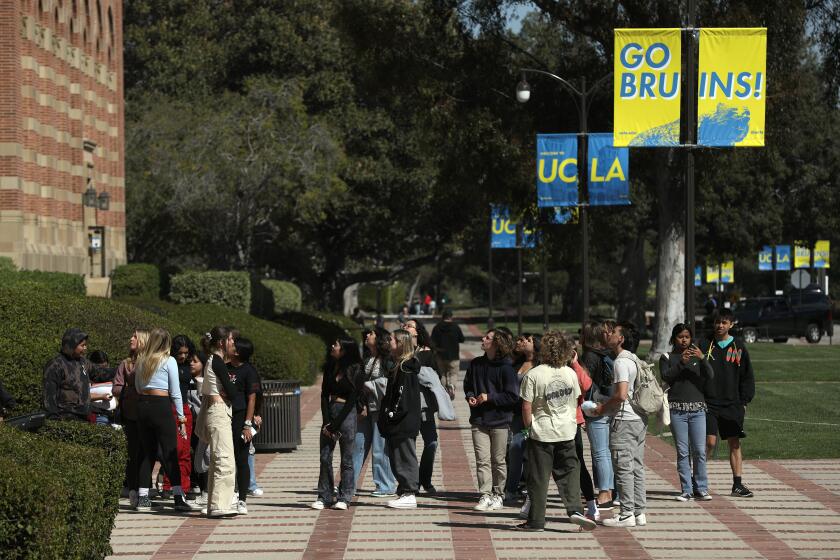California bullet train authority ordered part of a flawed bridge torn down
- Share via
Engineers have built about 24,000 bridges in California over the last century, but a new one under construction in Madera County for the state’s bullet train project shows that they can still lead to serious blunders.
Tutor Perini, the lead contractor building a 32-mile section of railway near Fresno, had completed part of a tall highway bridge that would go over future train tracks when the California High-Speed Rail Authority last year issued a “stop work” order. The firm was told to tear down the construction on the Avenue 8 bridge and start over, the agency said this week.
In a statement, the authority said the Avenue 8 bridge design did not meet its “level of quality for a work product” and showed “signs of distress.” Some time after last September, the authority had Tutor Perini start on an entirely different design, agency documents show. The decision has not been previously reported.
The rail authority said it is discussing who will bear the cost of the rework.
Ron Tutor, chief executive of Tutor Perini, said the redesign was not his firm’s fault and called the issue “trivial.”
“We designed it and they approved it and then they changed their minds,” Tutor said. “They had a change of heart.”
At least three other bullet train bridges in the Central Valley used the same design as the Avenue 8 bridge and are now being redesigned, according to a January rail authority status update, raising questions about whether potentially more costly designs will be required in the future. The previous design for Avenue 8, using what is known as mechanically stabilized earth walls, is generally considered cheaper than the new design, using cast in place abutments.
The rail authority has acknowledged that it is behind schedule and facing sharply escalating costs, but a new team of executives who took over this year has vowed to make improvements to the execution of the program and re-establish its credibility as the project comes under the leadership of a new governor next year.
Engineering experts say the bridge errors show such changes are badly needed.
“Having to tear down work and redesign it is an early warning sign of lack of program management,” said Robert Bea, a civil engineering professor emeritus at UC Berkeley and a member of the National Academy of Engineering. “It is very unusual. It is not common.”
Tutor Perini has won a series of prestigious construction jobs in recent years, but also had its share of setbacks. San Francisco transportation authorities ordered the firm and its subcontractor this year to tear out 3.2 miles of installed steel track in a subway project because it wasn’t strong enough.
Two months ago, the firm settled a suit by Los Angeles World Airports alleging that a runway completed by the firm in 2013 was defective and cracking apart. The company agreed to pay $28.3 million, airport records show. And the company is in complex litigation over a tunnel under downtown Seattle, in which a boring machine became stuck and portions had to be vertically extracted.
Exactly who will pay for the Avenue 8 bridge problem is undecided. The rail authority said in its statement that the cost “is with the contractor,” but acknowledged it is the subject of discussions involving a change order.
The Avenue 8 bridge, like many the authority is building in the Central Valley, will soar high above the surrounding pancake-flat farmland, meaning it will have high structural loads.
The bridge needs enough clearance for the rail’s elevated bed of stone ballast, the steel rail, the train and high-voltage overhead wires, along with the thick highway deck on top. All of that reaches about the height of a four-story building above ground.
The original bridge design had a retaining wall built with mechanically stabilized earth, which uses horizontal layers of reinforcement fabric to hold up retaining walls and concrete support pillars. Rail authority documents say thousands of cubic yards of soil were brought in to build the bridge approaches. The new design uses poured concrete abutments.
Mechanically stabilized earth structures are typically less costly to build than cast concrete systems, but have a higher failure rate, said an engineering executive who asked not to be identified to avoid professional repercussions.
“A mechanical stabilized earth wall looks good on paper, but unless it is done perfectly it can fail,” he said. “A poured-in-place wall can fail too, but it is more robust.”
Bea said he suspects the signs of distress cited by the rail authority involved cracks or fissures that developed from weak foundations. He said responsibility resides with the rail authority and the contractor, both of whom should have recognized problems much earlier.
Bea, whose career has spanned decades as an oil industry engineering executive and academic, said soil conditions in the Central Valley are as difficult as anywhere on Earth. He calculated the loads that the bridge would place on the weak soil at about 12,000 pounds per square foot, based on estimates of its dimensions and weight.
The rail authority has issued its contracts under a “design build” approach, in which state engineers and their consultants provide 15% of the design of structures and then leave contractors to complete the other 85%. Construction industry experts say the decision to issue contracts with only a 15% design completion was risky in a complex project in which the state has no prior experience. In many cases, government agencies issue such contracts with 30% of the design provided to the contract bidders.
The new design for the bridge was done by Tutor, the rail authority said.
“We have made significant progress with the new structure,” the agency said in its statement.
Follow me on Twitter @rvartabedian











